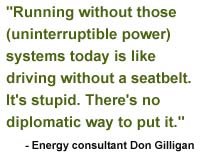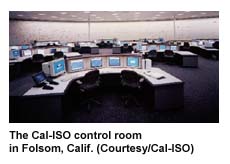|
Plan ahead for power woes
|
 |
August 9, 2000: 12:34 p.m. ET
Look at your energy consumption to protect your business and save money
By Staff Writer Steve Bills
|
NEW YORK (CNNfn) - After the lights go out, it's too late to start thinking about your energy management strategy. But while the electricity is still running, you have time to figure out how you will deal with a power crisis at your business.
Although it sounds like a flashback to the bad old oil-embargo days of the 1970s, the energy crisis of the 21st century is a different phenomenon, the product of a long-regulated utility industry adapting, creakingly, to the deregulated marketplace of the new millennium, at a time when the U.S. economy is in the midst of unprecedented growth.
California teetered last week on the brink of a "stage three" electricity shortage, as a West Coast heat wave combined with breakdowns at generating plants, putting electric demand in the state within 5 percent of the maximum output that was available.
Had reserve capacity fallen below 1.5 percent, authorities would have imposed "rolling blackouts" that would have shut down the electrical system, mostly in residential neighborhoods, during the heat of the afternoon, when demand typically peaks.
 This week, the California crisis seems to have eased somewhat. But scarcely noticed in the face of the West Coast drama was an action last Thursday by the New York Power Authority, which asked some of its business and government customers to reduce their demand under a voluntary program. This week, the California crisis seems to have eased somewhat. But scarcely noticed in the face of the West Coast drama was an action last Thursday by the New York Power Authority, which asked some of its business and government customers to reduce their demand under a voluntary program.
The World Trade Center in lower Manhattan was one of those affected. Employees turned off some of its lobby lights and shut down some elevators for part of the day, a spokesman said.
And this was on a day when the temperature peaked in New York at 82 or 83 degrees, said energy consultant Don Gilligan, head of the Predicate consulting firm in Foxboro, Mass.: "If we have a week of 95 degree days, we'll have some supply problems in the East as well."
Crunch in the midst of a boom
Why the energy crunch? Gilligan said it was in part the timing of utility deregulation, coming in a period when the U.S. economy was enjoying the longest uninterrupted growth cycle in history.
Each state typically takes two-to-three years to write the legislation to open its electricity market to competition, and it takes another two years for state utility commissions to rewrite their regulations after that, Gilligan said.
All of this means a great deal of uncertainty for risk-averse, regulated power companies. "They don't do anything unless they're sure of reimbursement," he said, adding, "Right now, you've got utility regulators in several states that are just paralyzed."
Consequently, power plant construction has been on hold now for several years across much of the nation, as 25 states are now at some stage of utility deregulation, according to the Edison Electric Institute, a trade group representing investor-owned utilities.
And as calls for reform now ring out in California, it appears the environment of political uncertainty is likely to persist.
Protecting your operation
That means business owners should take steps to protect their own operations from possible power disruption. Even if you are in an area where electricity supplies seem adequate, prudence is appropriate.
"At this point, very few operations can guarantee you 100 percent electricity all the time anyway," said Ed Van Herik, a spokesman for San Diego Gas & Electric, a unit of Sempra Energy (SRE: Research, Estimates). Storms can knock down power lines, or a delivery truck could run into the transformer outside your building, he pointed out.
 If a power failure occurs, you are not likely to receive advance notice. However, you can monitor the demand on the system if your energy provider posts such information on its Web site, as does the California Independent Service Organization (Cal-ISO), the non-profit organization that manages the state's power transmission system. If a power failure occurs, you are not likely to receive advance notice. However, you can monitor the demand on the system if your energy provider posts such information on its Web site, as does the California Independent Service Organization (Cal-ISO), the non-profit organization that manages the state's power transmission system.
First, make sure you protect your computers by installing an uninterruptible power source, energy consultant Gilligan said: "Running without those systems today is like driving without a seatbelt. It's stupid. There's no diplomatic way to put it."
A UPS unit is essentially a battery that plugs in between your PC and the wall socket. For a cost of about $100 per computer, you can provide at least enough protection to give you a chance to shut down the machinery in an orderly way so that you don't lose data or damage the equipment, Gilligan said.
Of course, if you run a server computer, you may want more robust protection. And don't forget to put a UPS on your phone switch as well: A power failure could cause you to lose voice mail, directory functions and other features of modern, digital telephone systems.
Beyond that, the steps you take depend largely on the business you're in. If you run a restaurant, for instance, you may need to remind the staff to keep the doors shut on the walk-in freezer while the power is off.
"It's one thing if you can't cook," Gilligan said, noting that many restaurants use natural gas for cooking anyway. "It's another thing if you have a freezer full of meat."
By the same token, you can save on your regular electric bills if you make it a point to turn off the lights in that walk-in freezer when no one is in there, or to turn the thermostat a few degrees warmer on a hot summer day.
Identify opportunities for savings
In most businesses, the biggest sources of power consumption are lighting, heating and cooling, said Gerard McLoughlin, a spokesman for the Edison Electric Institute. Especially in a deregulating market where energy costs can spike along with demand, he said, you can save money if you "identify the equipment in the area that consumes the most energy, especially if it's operating inefficiently or when it's not necessary."
That may mean replacing incandescent lighting with fluorescent fixtures, or replacing an old air-conditioner with a more energy efficient heat pump.
Your local power company may offer an energy audit for your business, just as many utilities do for residential customers. The electric power market, however, remains enormously fragmented, and the needs of business customers vary widely, making it difficult to offer general advice.
In markets where deregulation already has taken effect, you can shop among different energy suppliers to find the best deal. In order to do that effectively, you will need to know your "load profile," a description of how much energy your business needs, and when. Your energy audit may provide this information.
If you are an office employer, open 10 hours a day, you are likely to be using the most energy at the peak demand time -- your air conditioners working hardest in the afternoon when the day is hottest. You will find it difficult to get any great price breaks by bargaining.
On the other hand, if you run a commercial or manufacturing operation that either can shift work to the early morning or late evening hours, or if you operate two or three full shifts a day, demand management programs may offer you some savings.
Calculate your payback
To take advantage of pricing variables, however, you may need to replace your conventional electric meter with a "real time" monitoring system. To figure out whether such an effort would make sense for you, contact your local power distributor. For this, as for other energy-saving strategies, you can do a payback-breakeven calculation to see how long it would take to offset the initial expense through reduced power bills.
You might also check with your local chamber of commerce or other trade group to see if any group discounts are available with energy providers. Typically, "the members (of an organization) haven't bought into it. The leaders have bought into it," Gilligan said. "Until there's a real emergency, small business owners typically haven't paid much attention to these things."
You might even check into becoming your own power supplier. Technological advances, in the form of "microturbines," are becoming more affordable and could provide you a steady source of energy at a reasonable price, if you have the flat load profile to run the turbines continuously.
It also helps, Gilligan said, "if you have a use for the waste heat" that the microturbines, typically diesel-fueled, can generate. He suggested a commercial laundry, operating two or three shifts a day, might be a microturbine candidate, even if its power bills ran as little as $3,000-to-$4,000 a year. 
|
|
|
|
|
 |

|

